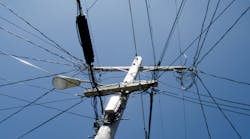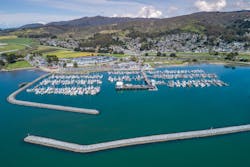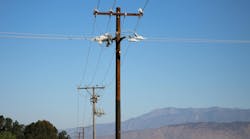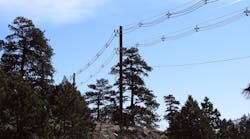California utilities have been challenged to upgrade their systems to prevent wildfire ignition and increase resiliency during wildfires. Particularly, some investor-owned utilities (IOUs) have come under scrutiny after utility-owned equipment was suspected of sparking wildfires. As a result, a large volume of distribution infrastructure required analysis and upgrading over a short period of time to meet California Public Utilities Commission (CPUC) requirements.
High fire threat districts are prevalent across the western U.S., from Washington state and Oregon to California and portions of northern Nevada. Utilities operating in this region are facing challenges not only in performing crucial work to mitigate the threat of fire to their operations and wider communities but also in sourcing contractors staffed by personnel who can perform the required work quickly and accurately.
An engineering, consulting and automation services company, EN Engineering leverages skills in project management, with an emphasis on responsiveness to utility needs. EN hires individuals who display technical expertise, can act quickly, are effective team players yet can work independently, are good communicators and have the proven ability to thrive in the challenging situations that high fire threat districts present.
A large California IOU has been an EN client since 2011 and, over the years, it has worked on a variety of projects, including wildfire mitigation efforts in high fire threat districts. The EN team together with G2 Integrated Solutions (G2-IS) — a national provider of critical asset integrity and compliance solutions for operators of natural gas and electrical infrastructure, which EN acquired in 2021 — have become one of the utility’s top performers for technical ability, quality and schedule adherence despite many shifts in targets and scopes of work along the way.
Vegetation Encroachment Analysis
One such project arose after the IOU experienced a fire in Paradise, California. The G2-IS data team was tasked with setting up a data collection effort using the ArcGIS Collector and Survey123 apps. The data collection process focused primarily on identifying hazard trees and other vegetation types that posed a risk of failing or making contact with the utility’s infrastructure. Risk assessment categories were created with a great deal of input from the lines of business that already supported electric operations to identify risk profiles of trees and other vegetation types. An enormous training effort was launched, involving onboarding hundreds of new field inspectors and training them in the use of the Collector app to conduct inventories of potential hazards to T&D assets.
Maps for each electric circuit were set up in Collector and further drilled down by specific lines in each circuit. Vegetation management for electric operations had not been set up to achieve such a high level of granularity prior to the Automatic Workload Repository. Graph transformation and visual modeling (GTVM) capable of this level of granularity only existed on the gas side of the business up to that point, but not on the electric side.
A data pipeline was built using view layers in ArcGIS Online (AGOL) to pipe data from initial inspections through to actual tree work using hosted view services. Maps were set up for all phases of the process, from initial vegetation inspections, environmental assessments, and prescribing work type and date to maps for tree crews, post-work validation and wood management. AWRR not only provides maps for data teams and project managers to view but also separate views for tree crews performing work, which was a new idea at the time. Contractors were required to be trained on Collector and Survey123 to validate work was completed in the field.
Because of the sheer number of hosted views, the process for creating them and the corresponding maps for each electric circuit was automated using the object-oriented, high-level programming language Python. This process also was used later to quickly set up fire maps when fires started that impacted, or were near, the IOU’s infrastructure. The fire maps allow for vegetation work input like that of AWRR and display electric infrastructure in relation to the fire boundary. The utility’s emergency-response personnel use them to gain rapid insights on fast-changing situations. What might have taken half a day to stand up prior to AWRR, could now be accomplished in under an hour. Views of asset data, fire boundary, vegetation input layers and other important reference data can be created and put into fire maps on short notice with scripts and processes developed during AWRR.
Ramping Up
As part of its work scope, EN completed 80 pole replacements and several new business projects for the utility over an initial trial period of seven months. The process for these projects involved field noting poles, designed using O-Calc Pro structural analysis software for utility poles, the client’s proprietary tools and its geographic information system (GIS) while following CPUC, the client’s standards and the General Order 95 standards. Additionally, these projects included joint-use applications, which required working with communication companies and following their standards. Some high fire threat districts required overhead-to-underground conversions.
After the trial period, the IOU invited EN to ramp up to meet the growing needs of the utility’s fire-hardening activities. Since that time, EN has completed more than 4000 pole replacements and designed more than 150 miles of overhead and underground medium-voltage electric distribution through high fire threat districts, including the Oro Fino circuit and Half Moon Bay circuit projects.
Oro Fino Circuit: This project scope included system hardening of 20 miles (32.2 km) of circuit, including overhead, underground, main lines and tap lines. EN replaced all overhead main line with 715 aluminum conductor steel-reinforced (ACSR) cable tree wire and 397 ACSR tree wire as well as all tap lines with 1/0 ACSR tree wire. Composite poles were installed along with wood poles, depending on the pole loading calculation and available material, per the utility’s standard, using O-Calc. EN also replaced all open wire secondary and uninsulated material with insulated secondary wire, using Alumoweld-aluminum conductor (AWAC), and insulated material, such as jumpers, tie wire and lead wires.
This project also required Caltrans transportation permits near the highway. EN took the data from the utility’s land department along with field measurements to complete permit and construction drawings. This included all existing utility locations, land elevations for profile drawings, soil type, and center-line and fog-line measurements. To ensure the appropriate wire size, EN engineers conducted voltage drop and voltage flicker calculations. EN also conducted wire-pulling calculations to determine where manholes and pull boxes were located.
Half Moon Bay Circuit: The scope of this project, in a rural area near Half Moon Bay, California, included hardening in place 1.2 miles (1.9 km) of tap lines and undergrounding an additional 800 ft (244 m) of primary line. The design called for all lines to be 1/0 ACSR tree wire and poles class one or larger. EN replaced all open wire secondary, AWAC and insulated material. The company surveyed all existing poles and staked new pole locations, working closely with the land and environmental departments to obtain easements for poles and anchors and to ensure the environmental impact was mitigated. Field engineers collected GPS coordinates and elevation of all existing and proposed locations.
Again, for the overhead portion, engineers and designers used O-Calc for the pole loading and AutoCAD to create the construction and schematic drawings. For the underground portion of this project, engineers worked closely with the land department to obtain easements for the new underground primary and secondary running lines, along with the installation of the new equipment. The engineers conducted a voltage drop and voltage flicker study, along with pulling calculations for the underground design.
Outlook
In addition to the examples described here, EN is performing work on other betterment projects for this IOU in key units, which involves a combination of undergrounding and overhead reconductoring within subdivisions and neighborhoods. Furthermore, EN also is working on electric vehicle charging and assessment programs. As more individuals and businesses are installing electric vehicle stations at their homes and businesses, respectively, they are finding the loads on their distribution system are causing failures. In turn, there is a need for upgrading their system, which could be an individual transformer or a circuit on that block or for the entire neighborhood.
Overall, as EN has continued to execute projects within this IOU’s wildfire hardening work streams, its scope of work has continued to grow along with an expanding workforce from a team of five to approximately 100 working on all programs for this California IOU today. EN is working with the utility now on a program to perform hundreds of miles of reconductoring work in its high fire threat districts every year for the foreseeable future.
Steven Parr ([email protected]) is a senior business development manager with EN Engineering. He found his home in the power industry after starting his career with ABB (now Hitachi) in an engineering development program where he spent time in project and sales engineering capacities for medium & high voltage
electrical equipment. For the past few years, he has been with EN Engineering focusing on helping electric utilities meet the growing needs of modernization, wildfire mitigation, and resiliency throughout the Rocky Mountains and Pacific Northwest. He holds a bachelor’s degree in mechanical engineering from Ohio State University.
Andrew Kovanis ([email protected]) is a GIS professional within the Department of Client & Project Services at G2-IS. Over the last four years Andrew has had the opportunity to develop new field data collection workflows and spatial analyses supporting various electric utility programs including access roads maintenance, hydroelectric encroachments, and vegetation management. He holds a bachelor’s degree in geography with an emphasis on GIS from Cal Poly Humboldt.




